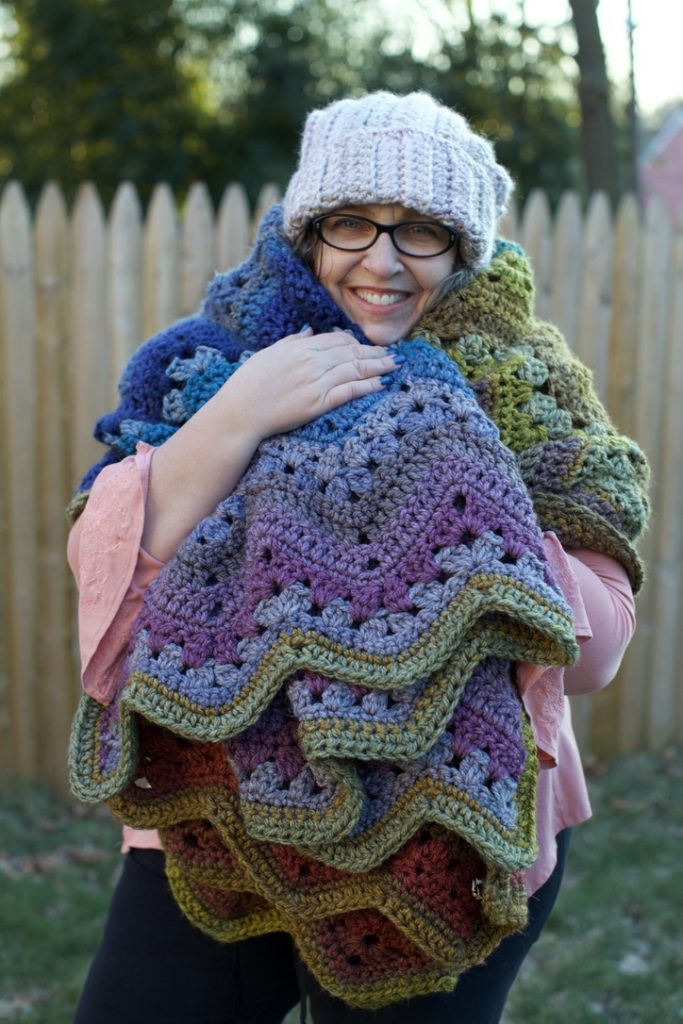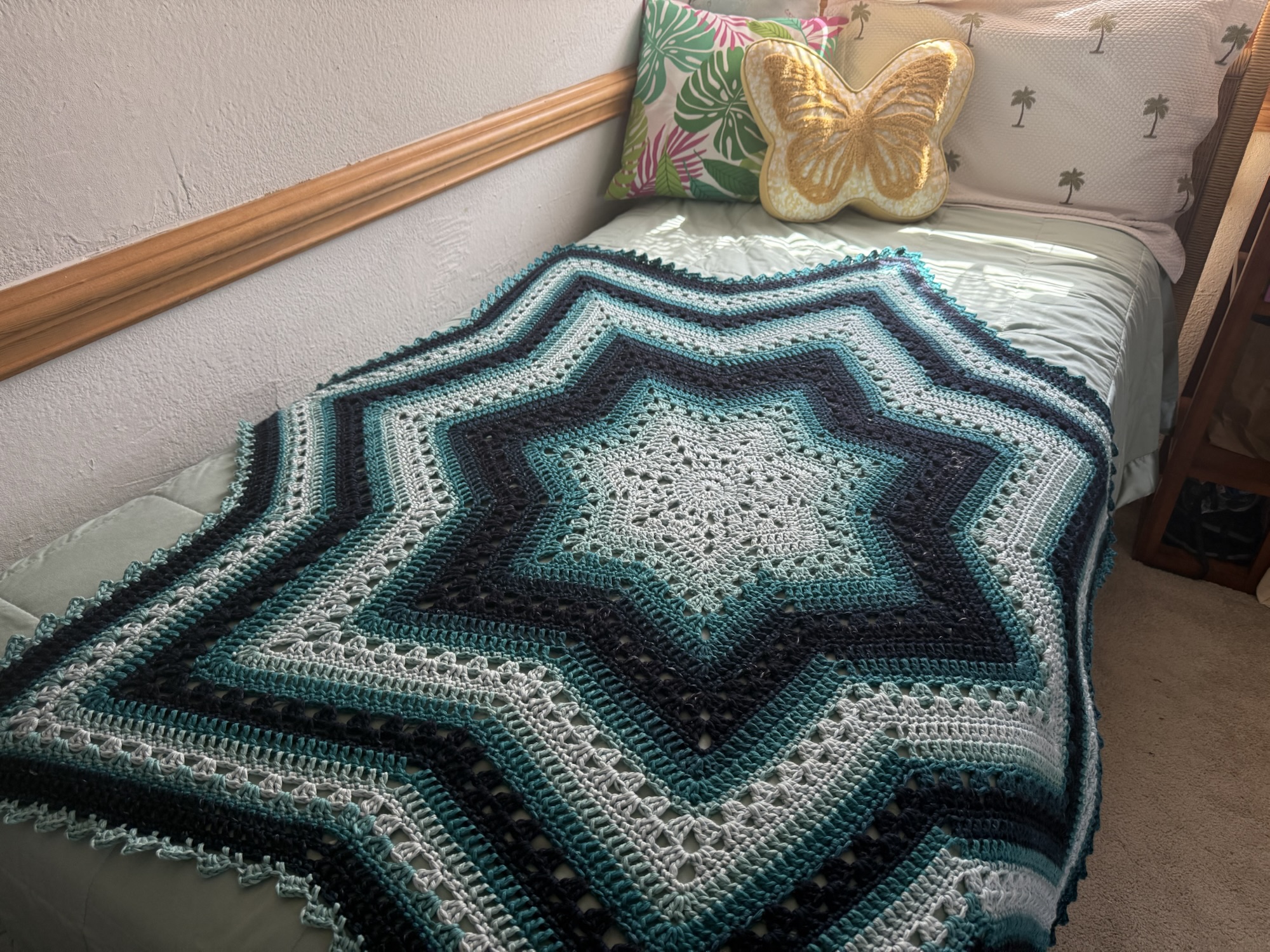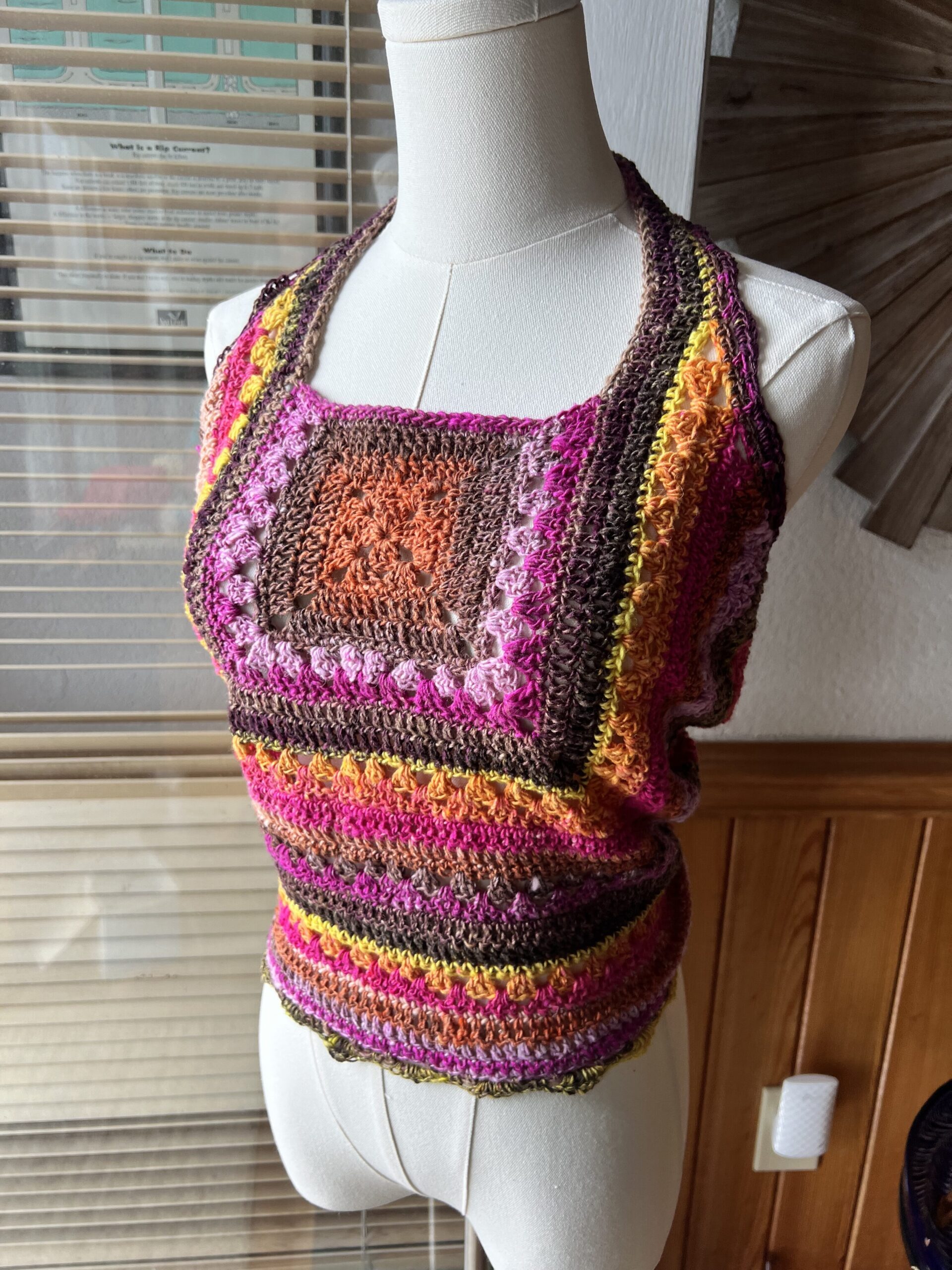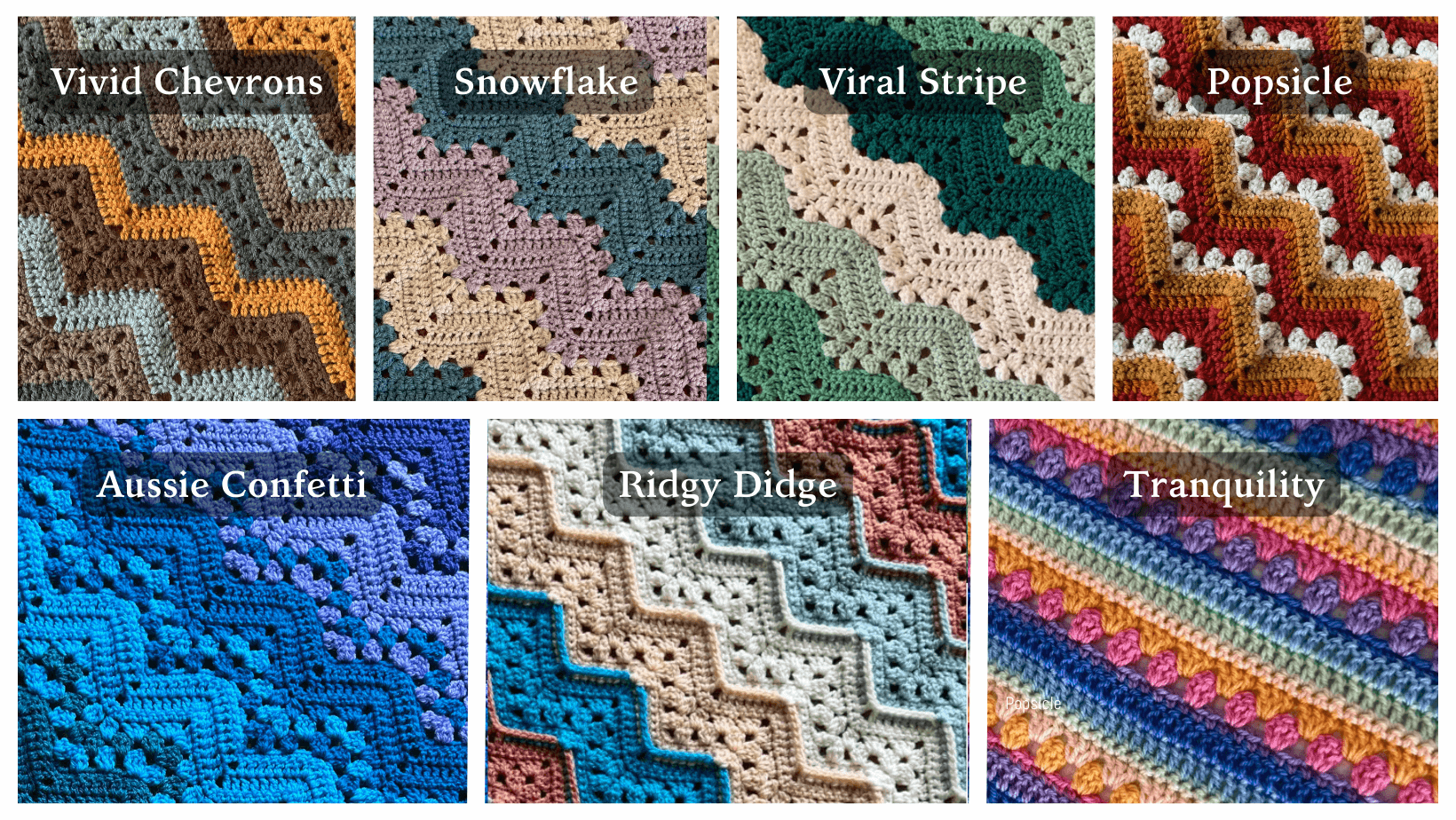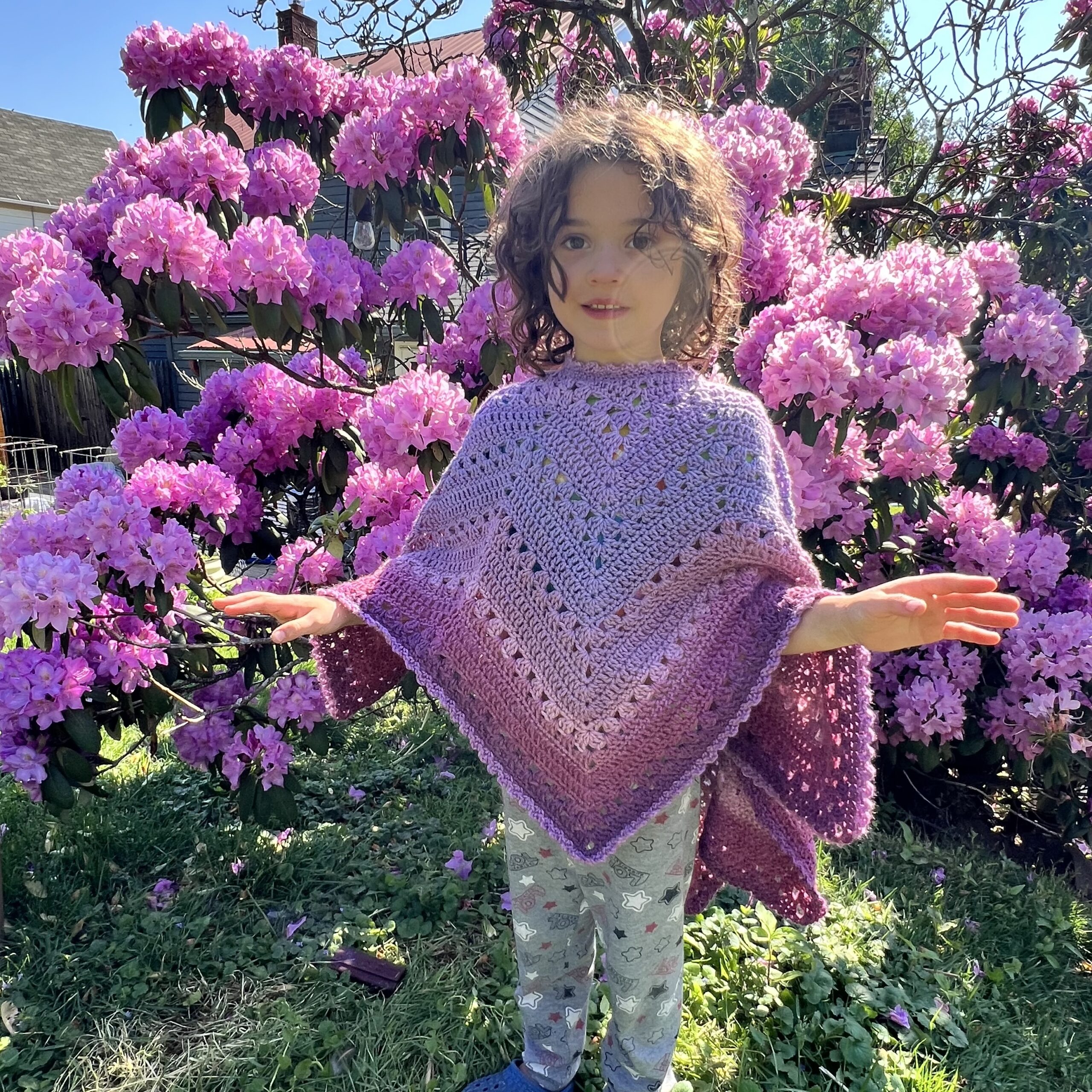6-Day Holiday Table Runner – Christmas Colors
This page contains affiliate links. If you click these links and buy something on the page they take you to, I may, at no additional cost to you, earn a commission. I only affiliate with products and companies I feel good about. Thank you for your support!
A variation of the classic crochet pattern the
6-Day Kid Blanket by Betty McKnit
Introduction
This crochet pattern is for a holiday table runner in the iconic 6-Day Kid Blanket stitches. It is striped in traditional Christmas colors and has an adorable candy cane striped edge that matches the 6-Day Star Holiday Tree Skirt. It is easily adaptable to different weights and types of yarn and can be made in any size.
There are also Hanukkah and Kwanzaa inspired versions of this pattern available on my website and in my pattern stores as well. I hope this project brings a festive touch to your holiday table and brightens your celebrations.
Details
US Terminology
Skill Level: Easy
Finished Size: Length: 28” (variable) Width: 10” (variable)
Converting US terminology to UK terminology
| US terms abbreviation | UK terms abbreviation |
| single crochet sc | double crochet dc |
| half double crochet hdc | half treble crochet htr |
| double crochet dc | treble crochet tr |
Materials
Less than one skein (380 yards) each of Worsted Weight Acrylic yarn, shown in Big Twist Value in Varsity Green, Varsity Red, and White.
Crochet Gauge: 4in = 13sc x 15 rows
US I/5.5 mm hook and J/6 mm
Scissors
Yarn Needle
Abbreviations:
ch: chain
dc: double crochet
dc3tog: (This stitch is a cluster, not a decrease).
Work dc3tog into one stitch – not over three stitches
[yarn over, pull up a loop, yarn over and pull through two loops] 3 times in the same stitch every time. Yarn over, and pull through all 4 loops on the hook. dc3tog complete.
fdc: foundation single crochet
hdc: half double crochet
rep: repeat
sc: single crochet
sk: skip
sl st: slip stitch
sp(s): space(s)
sts: stitch (es)

Some Things to Consider Before You Start
Does it really only take six days to make?
Yes. As written, this project can be worked up in an evening. If you upsize, be prepared for it to take longer, but even the longest of table runners could be completed in six days of easy crochet.
I highly recommend that you swatch on 30 sts following the pattern as written and this YouTube video. Swatching will help you learn the stitches and avoid some common errors before casting on hundreds of stitches.
You should definitely swatch if you plan to lengthen this project or use a different weight than worsted. More on this below.
How to Resize
The measurements and starting chains given are options. For perfect sizing, make a swatch on 30 chains with your chosen yarn and hook, following the pattern as written, and do the math for a custom-sized runner. To add length, add points to this pattern, adding 13 sts for each additional point. The resize multiple is 13 x (# of points) + 4.
For a wider runner, work additional pattern repeats, although a table runner is traditionally around 8-10” wide. Keep in mind that the pattern ends with a half-repeat on row 4 (not 7) before squaring off the top edge.
In my tension, in worsted weight, each repeat added 4.5” of length. If you would like to use a lighter weight of yarn, you will need to make a swatch and measure it to determine your starting chains and number of repeats needed.
Color Changes
This pattern gives specific color changes, however these stitches can take on many different looks depending on where you change colors. If you would like to customize your stripes, here is an article about the 6-Day Kid Blanket to help you decide how to do that. Cake yarn also looks amazing in the 6-Day Blanket stitches; choose your favorite colorway and “let it flow.”
To change yarn on color changes, draw the new color through the last two loops of the last stitch of the row before the color change.
About the Row Numbers
In order to provide consistency across all of the 6DKB pattern variations, I’ve numbered the rows to correspond to the original 6-Day Kid Blanket pattern. You will be guided to work the rows in the proper order; don’t overthink a change in the sequence.
Stripe Symmetry
Remember that the piece ends on row 4, and so it has a half repeat at the top of the work. The top square off pattern stitches do not work if you finish on row 7. Be aware of this as you plan your stripes and color repeats.
Side edges
Some crocheters have had issues with the side edges of their work curling. My suggestion is to work the last stitch of each row by inserting the hook from back to front, instead of from front to back.
Starting Hook
I recommend making your chain with a hook .5 mm larger than the hook you plan to work your project with. You can also instead start with fsc, in which case you will need one fewer chain than given, and can skip Setup Row 1.
Begin Pattern:
With Green and larger hook, ch 82 (multiple of 13+4)
Place stitch markers along your chain every 20 stitches to help keep track of your stitches.
Setup Row 1: starting in second ch from hook, sc across.
Turn
Change to smaller hook for the rest of the project.
Setup Row 2: ch 1, 5 sc, 6 hdc, *7 sc, 6 hdc repeat from * to last 5 st, 5 sc.
Turn
Setup Row 3: ch 1, 3 sc, *3 hdc, 2 dc, ch 2, 2 dc, 3 hdc, sc, sl st, sc, repeat from * to last 13 sts, 3 hdc, 2 dc, ch 2, 2 dc, 3 hdc, 3 sc.
Turn
Setup Row 4: ch 1, 3 sc, *3 hdc, 2 dc, [dc, ch 1, dc] in ch 2 sp, 2 dc, 3 hdc, sc, sl st, sc, repeat from * to last peak, 3 hdc, 2 dc, [dc, ch 1, dc] in ch 2 sp, 2 dc, 3 hdc, 3 sc.
Turn
Change to Red
Setup Row 5: ch 1, sc, sk 1, 7 sc, *3 sc in ch sp, 7 sc, sk 1, 7 sc, repeat from * to last peak, 3 sc in ch sp, 7 sc, sk 1, sc in last st.
Turn
Change to White and Proceed to Row 2

Row 2: ch 3, sk first 3 sc (the sc below your turning chain counts as 1)
[3 dc in next sc, sk 2] twice, [3 dc, ch 3, 3 dc] into next sc, *sk 2, 3 dc into next sc, sk 2 sc, dc3tog, sk 4, dc3tog, sk 2, 3 dc in next sc, sk 2, [3 dc, ch 3, 3 dc] in next sc; rep from * to last 9 sc, sk 2 sc [3 dc in next sc, sk 2] twice, dc into last sc.
Turn
Remember that dc3tog is a cluster and not a decrease.
Row 3: ch 3, sk sp between turning ch and next 3 dc group, 3 dc into each of next 2 sp, [3 dc, ch 3, 3 dc] into ch 3 sp, *3 dc into next sp, dc3tog into next sp, sk next sp, dc3tog into next sp, 3 dc into next sp, [3 dc, ch 3, 3 dc] into next ch 3 sp, rep from * to last 3 sps, 3 dc into each of next 2 sps, 1 dc into sp between last 3 dc group and turning ch.
Turn
Change to Red
Row 4: ch 1, sc into first dc of the row (the one right below your turning chain), sk 1, sc into each of next 8 dc, *3 sc into ch 3 sp, sc into each of next 14 sts, repeat from * to last ch 3 sp, 3 sc into last ch 3 sp, sc into each of next 8 dc, sk 1, sc into top of turning ch.
Turn
Change to Green
Row 5: ch 3, sk first 2 sc of the row below (the sc your turning chain is coming out of counts as the first one). 8 dc, *3 dc into next sc (you should be working these into the center stitch of the 3 sc.) 7 dc, sk 2, dc into each of next 7 sc, rep from * to last 11 sc, 3 dc into next sc, 8 dc, sk 1, dc in last st.
Turn
Row 6: Ch 3, sk first 2 dc in the row below (the dc below your turning chain counts as 1), 8 dc, *3 dc into next dc (you should be working into center stitch of 3 dc), 7 dc, sk 2, 7 dc, rep from * to last 10 dc, 3 dc in next dc, 8 dc, sk last dc, dc into top of turning ch.
Turn
Change to Red
Row 7: Ch 1, sc into first dc (the same one the turning chain is coming out of), sk 1, sc into each st to last dc, sk last dc, sc into top of turning ch.
Turn
Change to White
Repeat Rows 2-7, changing colors as indicated above – Rows 2&3 White, Rows 4 and 7 Red, and Rows 5 and 6 Green.
Repeat rows 2-4 one time in appropriate colors. Change to Green and proceed to Square Off Rows.
In Green, square the top edge:
Square off Row 1: ch 3, counting the stitch under the turning chain, sk 2, 3 dc, 3 hdc, 2 sc, sl st, 2 sc
*3 hdc, 2 dc, sk 2, 2 dc, 3 hdc, 2 sc, sl st, 2 sc, repeat from * to last 8 sts, 3 hdc, 3 dc, sk 1, dc in last sc.
Turn
Square off Row 2: ch 3, counting the stitch under the turning chain, sk 2, 3 dc, 3 hdc, sc, sl st, sc, *3 hdc, 2 dc, sk 2, 2 dc, 3 hdc, sc, sl st, sc, repeat from * to last 8 sts, 3 hdc, 3 dc, sk 1, dc into turning ch.
Turn
Square off Row 3: ch 3, counting the stitch below the turning chain sk 2, 3 hdc, 7 sc, *6 hdc, 7 sc* until 5 st remain, 3 hdc, sk 1, hdc in last st.
Turn
Square off Row 4: ch 1, sc in same st and in each st across, work 3 sc in the last st of the row. Do not turn or fasten off.
Side Edges
Continuing in Green, rotate the work and continue to sc down the sides of the stitches. Use the turning chains, the sc and dc stitches as foundation chains, working under 2 threads of each stitch and leaving one thread below.
There is no set rule for how many stitches you should put into the side of each stitch. Find out what works for your tension. In general, two stitches into each dc and turning ch and one into each sc with occasional skips works for me, but your tension may be very different from mine. Lay your work down often and check to make sure that your edge does not ruffle (too many stitches) or pull (too few).
Continue working sc around the piece, working 3 sc in the corners, working across the bottom of your starting ch or fsc, up the other side same as the first, and across the top. Fasten off.

Candy Cane Border
Hints for working this edge:
- be prepared. It takes forever.
- Take time to lay your work down often and check for ruffling. If your edge ruffles, you should skip a stitch every 5 or even 3 stitches to keep your work flat.
- Your yarn will twist if you don’t take measures to untwist it. I suggest keeping the ball of Color A stationary, and move the ball of Color B under or over Color A every time you use it. If you don’t you will have to stop occasionally and untwist your yarns.
Use Color A: Red and Color B: White for Candy Cane Stripes.
Join Color A with standing sc to any stitch along the side of the work. Ch 3. Drop Color A from your hook, join Color B with standing sc to the next st, ch 3. *Drop Color B from your hook, and working in front of Color B, sc, ch 3 with Color A. Drop Color A from your hook, and working in front of Color A, sc, ch 3 with Color B. Repeat from * around. Finish with last sc of each color in the same st as first sc of the round.
Fasten off. Weave in ends.

An international community of yarnful makers and friends.
- New pattern pre-releases
- Exclusive patterns never released to the public
- Have access to Betty’s ad-free .pdf library of patterns (3-4 patterns/month)
- Access to Betty’s Design Workshop
- Uplevel your knitting and crochet skills
- Enjoy regular crochet alongs, knit alongs, and classes
- Make like-minded friendships during our weekly social and educational events
- Bonus content every month
This pattern is 100% original and the intellectual property of Betty McKnit/Beth Elliott. This pattern, The 6-Day Kid Blanket, “6DKB,” and all derivative works are protected by copyright. Publishing translations, corrections, variations, or tutorials of this pattern, online or elsewhere without written permission from the owner is a violation of copyright.
Items created with this pattern may be used for commercial sale with credit to Betty McKnit in your listing.
Credit the designer by tagging @bettymcknit in social media posts..
The 6-Day Crochet stitch pattern was inspired by “Vivid Chevrons” #110 from 200 Ripple Stitch Patterns by Jan Eaton.
©Beth McKee Elliott/Betty McKnit®
www.bettymcknit.com
Beth McKee Elliott
aka Betty McKnit
Beth McKee Elliott, also known as Betty McKnit, is a crochet and knitting designer, instructor, community leader, and Master Somatic Movement Therapist and Educator. Her signature style, 6-Day Crochet, is showcased in the viral crochet patterns the 6-Day Kid Blanket and 6-Day Star Blanket.
She specializes in Somatic Crochet and Knitting, a mindfulness practice that combines crochet/knitting with body awareness techniques to prevent injury and promote well-being and creativity in crafting.
In addition to being a crochet designer, Beth is a choreographer. She is the creator and director of Small Plates Choreography Festival, Haven Movement Company, and the Dance Maker Podcast.
